The Water Jar is an asterism formed by four relatively bright stars in the constellation Aquarius: Gamma, Pi, Eta, and Zeta Aquarii. Also known as the Urn, the Y-shaped asterism represents the water jar from which the celestial Water Bearer pours water toward the mouth of the Southern Fish (Piscis Austrinus). The mouth of the Fish is marked by Fomalhaut, one of the brightest stars in the sky.
Depictions of Aquarius typically show a young man pouring water from an amphora. The water flows in a curving stream from Kappa Aquarii to Fomalhaut. The stream of water was once considered a separate constellation. The ancient Greek authors Aratus and Eratosthenes called it Hydor (the Water), while the 19th century American astronomer Elijah Hinsdale Burritt called it Fluvius Aquarii, meaning “the stream (or river) of Aquarius.”
In Greek mythology, Aquarius is associated with Ganymede, the cupbearer to the Olympian gods. Ganymede was the son of King Tros of Dardania, the founder of Troy. He was described by Homer as the most beautiful of mortals. In the myth, Zeus was infatuated with the boy and he either sent an eagle (represented by Aquila) or transformed himself into one to bring Ganymede to Olympus to serve as cupbearer. It is said that Zeus gave Ganymede eternal youth and immortality on Olympus, and later placed him among the stars.
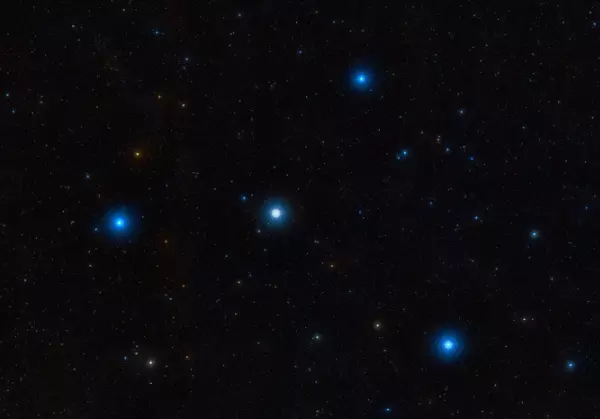
The Water Jar, image: Wikisky
Location
The Water Jar can be found using the stars of the brighter constellation Pegasus. The asterism lies south of the imaginary line connecting Markab at the southwest corner of the Great Square of Pegasus and the supergiant Enif, the brightest star in Pegasus. Enif lies just west of the Great Square and is believed to share the same origin as Sadalsuud and Sadalmelik, the brightest stars in Aquarius.
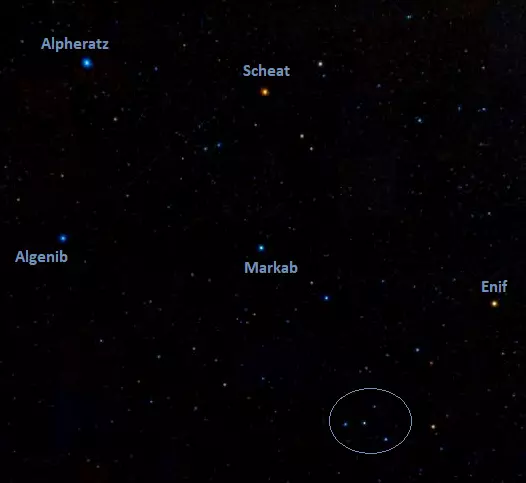
Water Jar location, image: Wikisky
The Water Jar can be used to identify Sadalsuud and Sadalmelik. The two yellow supergiants appear just west of the asterism. Sadalmelik is found along the imaginary line extended from Eta to Zeta Aquarii, while Sadalsuud is the brightest star southwest of Sadalmelik.
The bright globular cluster Messier 2 lies roughly on the imaginary line extended from Zeta Aquarii, the central star of the Water Jar, through Sadalmelik. With an apparent magnitude of 6.3, the cluster is visible in binoculars and easily observed in small telescopes. It is one of the oldest known globular clusters in the Milky Way. It lies approximately 55,000 light years away.
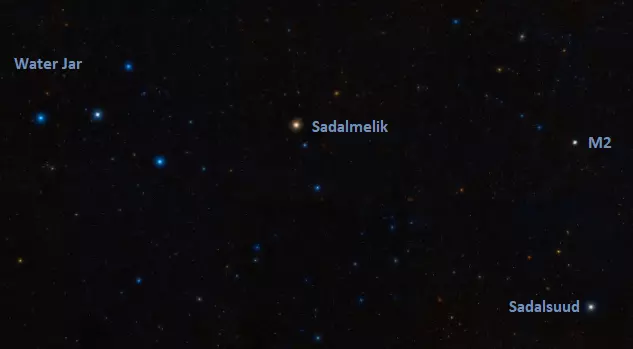
The Water Jar, Sadalmelik, Sadalsuud and Messier 2, image: Wikisky
A line extended from Eta Aquarii, the easternmost (left) star of the Water Jar, through Enif in Pegasus leads to the Great Pegasus Cluster (Messier 15). M15 is slightly brighter than M2, with an apparent magnitude of 6.2. It also appears larger and is much closer to us, at a distance of 33,000 light years.
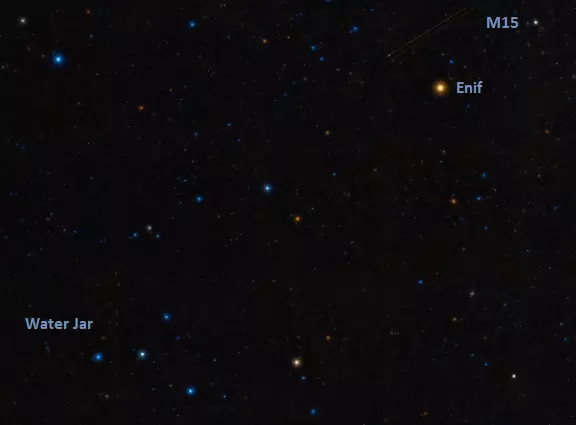
The Water Jar, Enif and Messier 15, image: Wikisky
Facts
In Chinese astronomy, the four stars of the Water Jar form an asterism known as Tomb (墳墓, Fén Mù), which represents tomb hills and is part of the larger Roof mansion.
In Arabic astronomy, the pattern formed by the four stars was known as al Aḣbiyah, meaning “the Tent.” Three of the stars had traditional names that were associated with the asterism. Gamma Aquarii was known as Aoul al Achbiya (translated into Latin as Prima Tabernaculorum) or “the first luck of the homes (tents)”. Pi Aquarii was called Wasat al Achbiya (Media Tabernaculorum), “the middle luck of the homes (tents),” and Zeta Aquarii was known as Achr al Achbiya (Postrema Tabernaculorum), “the end of luck of the homes (tents).” What these names referred to is lost to history. Eta Aquarii did not have a name associated with the Tent asterism, but was historically known by its Greek name, Hydria, and the Hebrew Deli.
The asterism is remembered in the name of Gamma Aquarii, now formally known as Sadachbia. The name is derived from sa‘d al-’axbiyah, meaning “luck of the homes” or “luck of the tents.” The other three stars of the Water Jar do not have formal names.
Stars
The stars that form the Water Jar are not physically related to each other, but merely appear in the same line of sight when seen from Earth. Zeta Aquarii, the oldest, brightest, and nearest of the four at 92 light years, lies at the centre of the asterism. Pi Aquarii, the faintest and most distant, lies 780 light years away and is by far the most luminous of the four, as well as the only supernova candidate in the group. All four stars are younger than the Sun, but since they are also more massive, they will not live as long as our star.
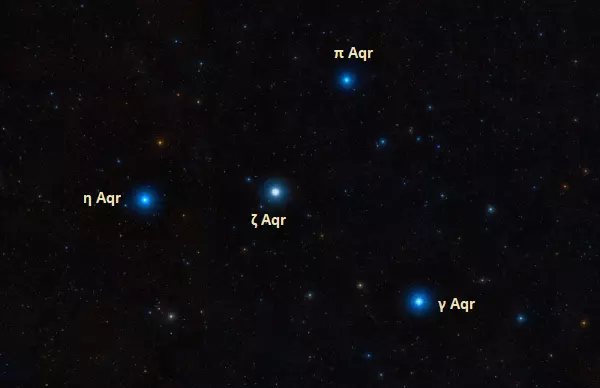
Water Jar stars, image: Wikisky
Zeta Aquarii
Zeta Aquarii is the brightest of the four stars that form the Water Jar. It is a triple star system with a combined apparent magnitude of 3.65. The system consists of two visible components: a white main sequence star of the spectral type F3 V, designated Zeta Aquarii A, and Zeta Aquarii B, a white subgiant with the stellar classification F6 IV. Zeta Aquarii A is an astrometric binary system. It has an invisible companion whose existence is inferred from the fact that the primary component seems to orbit around an empty point in space.
With an estimated age of 1 billion years, Zeta Aquarii A is the oldest of the four Water Jar stars. It has a mass of 1.4 solar masses and spins with a projected rotational velocity of 62 km/s. The companion is less massive, with 60% of the Sun’s mass. The two stars orbit each other with a period of 587 years.
Sadachbia – Gamma Aquarii
Sadachbia is a white main sequence star of the spectral type A0 V. It has a surface temperature of 10,637 K and a mass 2.49 times that of the Sun. It is much younger than our star, with an estimated age of 158 million years. It is a suspected binary system, but the existence of a companion has not been confirmed.
Sadachbia has an apparent magnitude of 3.849 and lies approximately 164 light years away.
Eta Aquarii
Eta Aquarii is another young star, with an estimated age of only 65 million years. It has the stellar classification of B9IV-Vn, indicating a blue star that is already coming to the end of its main sequence lifetime and may have already evolved into a subgiant.
The star has a mass about 2.96 times that of the Sun and a radius 2.77 times solar. It is 102.8 times more luminous than the Sun, shining at magnitude 4.04 from a distance of 168 light years.
Eta Aquarii is a very fast spinner, with a projected rotational velocity of 271 km/s. Like other fast rotating stars, it is flattened at the poles and has an equatorial bulge. Its equatorial radius is 24% larger than its radius at the poles.
Pi Aquarii
Pi Aquarii is the largest and most massive of the Water Jar stars. With a mass 10.7 times that of the Sun, the star may end its life as a supernova. It is a blue giant or subgiant of the spectral type B1III-IVe. As it evolved away from the main sequence, it has expanded to a size of 6.2 solar radii. Like Eta Aquarii, it is an exceptionally fast spinner, with a rotational velocity of 215 km/s. Its estimated age is only 5-15 million years.
Pi Aquarii is classified as a Gamma Cassiopeiae variable. It exhibits variations in brightness from magnitude 4.42 to 4.87 over a period of 83.8 ± 0.8 days.
The star is exceptionally hot and luminous, shining with 7,302 solar luminosities with a surface temperature of 27,094 K. This is why it is visible to the unaided eye from a distance of 780 light years.
The best time of year to see the stars of the Water Jar is during the autumn months, when Aquarius is high above the horizon in the evening sky.